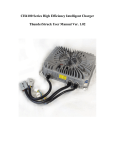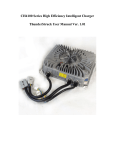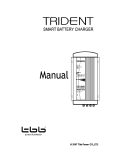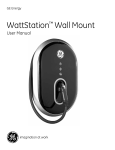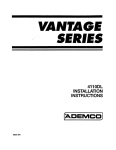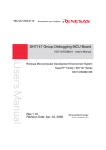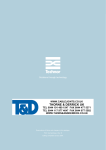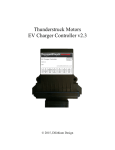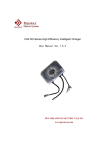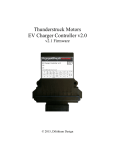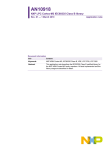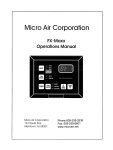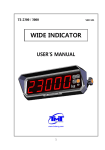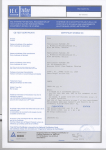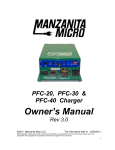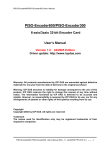Download CH4100 Series High Efficiency Intelligent Charger ThunderStruck
Transcript
CH4100 Series High Efficiency Intelligent Charger ThunderStruck User Manual Ver. 1.03 Table Of Contents I. Product Overview II. Safety III. Preventing Leakage and Fire 1.Correct use of Breakers, Sockets and Cables 2. Correct Use of Input Connections 3. Charging Environment Requirements IV. Regular Maintenance V. Technical Specifications VI. Parts List VII. LED Charge Light Information VIII. Appearance and Installation Dimensions IX. Connections and Wiring X. Faults & Solutions I Product Overview The CH4100 series high efficiency intelligent charger is designed to charge traction batteries of electric vehicles. This series of products adopt the most advanced technologies such as LLC resonant, active power factor correction, microcomputer measurement and control, digital adjusting, and extremely water resistant technology. Its features include: wide input voltage range, high input power factor that significantly reduces the input current as well as heat generated from the input cable, and Low harmonic current that reduces interference to other electric equipment. Full range soft switching is used to achieve high conversion efficiency and very little electromagnetic interference. The charger is designed according to IP66 protection grade and is highly water resistant. It is also small in size, lightweight, quiet, beautiful, simple to install and of course easy operation and maintenance. The charger uses microcomputer measurements and control technology, the embedded CPU can accurately detect battery voltage and charge current. The charger has temperature compensation functions, as well as automatic shut down after being fully charged. Reverse battery connection protection as well as output short circuit protection, AC input under voltage protection, and overheating protection . These functions help to ensure safe and reliable use. II Safety 1. Please do not disassemble the charger; this may cause electric shock or other injuries. 2. If the charger needs to be connected to an AC power supply with extension cables, please make sure that the extension cable can withstand the maximum input current (GB 2.5mm2 copper core cable is recommended to be used), and limit the extension cable length within 10m. 3. Don’t place the charger where it can get wet, this may cause damage to the charger as well as electric shock to the operator. 4. The charger’s DC output plug should be connected reliably to the socket, if they are damaged or loose, please replace them immediately, otherwise it will cause overheating in the plug position, and can even cause fire. 5. If the charger produces any abnormal sound or smell while on, please unplug the power immediately and contact the service department. Do not attempt to open the charger case. 6. Make sure that all air vents are unobstructed to prevent charger overheating. Do not place the charger near a heat source; the charger should be left with enough space to ensure proper ventilation. 7. Please disconnect the charger's AC input power if you need to move it. 8. Make sure that AC power supply voltage matches chargers’ input voltage. For inquiries, please contact your supplier or local power Supply Corporation. 9. Battery voltage and the nominal voltage of the charger must be matched or it could damage both the charger and the batteries. 10. To avoid damage to the charger’s cables, do not pull, twist or shake the cables or the connection terminals. If the cable is worn, please replace it immediately. III Preventing Leakage and Fire 1. Correct use of Breakers, Sockets and Cables 1. Use copper core cables with flame-retardant jackets. The cables’ core diameter must be at least 2.5mm in diameter. 2. Prevent plugs, sockets from coming in contact with water. Note: According to statistics, 80% of electric car fires occur during charging. The main reasons for this include insufficient core diameter, size of cables, poor quality plugs and sockets, poor contact of plugs and sockets, poor flame-retardant sheath or shells of breakers, plugs and sockets and so on. 2. Correct Use of Input Connections Make sure that the plug is clean, undamaged and free of dirt before charging. 3. Charging Environment Requirements Have it be spacious and away from flammable materials. Avoid mounting/placing the charging plugs, charging cables or the charger itself on car cabs, synthetic seats and other flammable objects. 4. Lithium Safety A lithium battery pack should have a battery management system to ensure safe charging. A battery pack with no BMS can be a very dangerous thing. We are not responsible for damage to batteries due to using a charger with no BMS. Most prismatic lithium batteries should be contained in a manner that prevents them from swelling during charging and discharging. Consult your battery manufacturer’s recommendation for the best way to package your cells. IV Regular Maintenance 1. Check the J1772 Socket regularly for corrosion or other conduction inhibitors. Poor contact may result in overheating and burning inside the socket, which although unlikely could cause fire. 2. Make sure to use a charger that has a dedicated breaker and wire running to it. 3. Make sure that the charger’s shell and cooling fan are free of debris and dirt. V Technical Specifications Rated input voltage: 220VAC 50/60Hz Input voltage range: 85~265VAC (Note: When the Input voltage is lower than 185VAC, the output power will be limited to 1.5KW) Power Factor: ≥ 0.99 @ 220VAC input, full power output; Total Harmonic Current: ≤ 5% @ 220VAC input, full power output; Nominal output voltage: 144V Maxim output voltage: 180V Rated output current: 15A Voltage regulation accuracy: ≤ 0.5% Current regulation accuracy: ≤ 2% Conversion efficiency: ≥ 95% @ 220VAC input, full power output Protection class: IP66 Audible Noise: ≤ 40dB Seismic rating: Designed according to IEC60335-2-29-2004-Part.21 Working temperature: -25~55°C (Note: models whose output power greater than 2KW Storage temperature: - 40~80°C Recognition certificates: CE SGS will ensure 2KW output at 60°C. ) VI Parts List A - AC Input Cables B - DC Output Cables C - Signal Cables D - Charging Indicator E Mounting plate F Shell G - Cooling Fan and Fan Cover VII LED Charge Light Information When... Then... Green Light Flashing It is Charging Normally Flashing Yellow, Red and Green in Various Orders Charging has recently stopped or has a Fault with Charger or Batteries. Contact Thunderstruck-ev.com. VIII Appearance and Installation Dimensions Do not bend the wires coming out of the charger until they have at least 50mm of space from where they enter the shell of the charger. Insure that there is a 50mm gap above the charger to allow for proper ventilation. IX Connections and Wiring Input Cables Note: The Yellow and Pink wires are not used, Refer to the EVCC Manual for more details on EVCC wiring. Output Cables X Faults and Solutions If your charger is not working correctly, you can refer to the table below: Fault Battery temperature Sensor Fault Battery not connected Analysis External battery temperature sensor is fault or not connected Battery is not connected or reverse connected Charging environment temperature is too high; cooling fan is fault; air vents are obstructed Solutions Check sensor connection or change a new one Check and connect the battery correctly Place the charger in lower temperature environments and retry; Check whether cooling fan is at fault or air vents are obstructed Input fault protection Poor contact of charger’s input side; Charger is broken If no poor contact phenomenon occurs, please contact us Charging timeout Battery is damaged or aging Check and replace battery Battery Overheating Battery is damaged or aging Check and replace battery Internal temperature Sensor fault Charger is broken inside Please contact us Output voltage Feedback fault Charger is broken inside Please contact us “Full Power ”after Short charging Battery is broken; Poor contact between charger and battery; Battery has been fully charged; Check whether the battery is damaged; battery connecting cables are firm ; the battery is fully charged Battery temperature becomes more than 50°C Battery is aging; Battery voltage is lower than the nominal voltage of the charger Check the battery, and replace bad battery; Reselect charger that match battery voltage level . Battery is aging Cables are too long or too thin Between the charger and battery Battery is aging Replace the battery Reduce the output cables back to initial length Replace the battery Check if there are foreign matters around the fan and remove them Check whether the cooling fan is working correctly, or contact us to replace the fan. Over-Temperature Protection Low battery capacity after full charge Charging time becomes too short or too long Charger overheating protection LED indicator lights but no charging Connectors are not connected firmly, or the polarity is reversed; Battery is disconnected Connect all connectors correctly and recharge Replace your battery with a new battery Check AC power supply and AC input is not connected firmly LED indicator chargers’ input cables doesn’t light Charger is broken inside Please contact us If your charger still does not work correctly after referencing the above list, please record the state of the fault and charge indicator information, then contact us. Battery is broken












